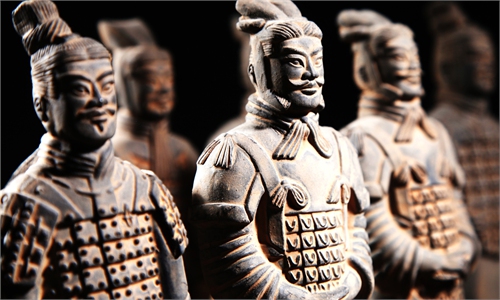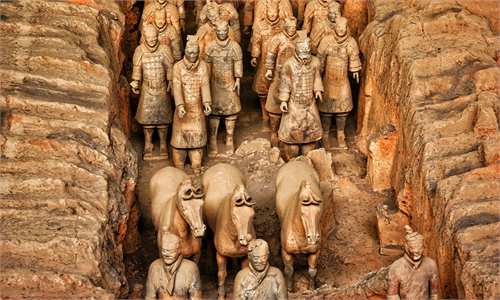ARTS / CULTURE & LEISURE
Trends: New excavation of the Terracotta Warriors Pit

The Qin Dynasty (221BC-206BC) Terracotta Warriors in Xi'an, Shaanxi Province Photo: IC
After 13 years, the third excavation of the Terracotta Warriors Pit 1 ended in 2022. Only a bit more than 400 square meters were excavated, accounting for 3 percent of the 14,260 square meters in Pit 1.A total of five complete swords, ranging from 88 centimeters to 91 centimeters in length, were unearthed during the excavation, all of which were designed for soldiers. The excavation of Pit 1 from 2009 to 2022 resulted in the discovery of a total of more than 220 pottery figurines, 16 pottery horses and other relics.
Sanqin Metropolis Daily
More than 300 shadow play puppets are on display in Shanghai at an exhibition jointly hosted by the Museum of Shanghai Culture and the China Shadow Play Museum.
The exhibition integrates Shanghai cultural elements into shadow puppet art, ranging from the shadow puppet records produced in Shanghai during the Republic of China era to the modern Xiaojiaochang New Year pictures.
The exhibition also demonstrates the production tools and the techniques used to make shadow puppets. These detailed shadow puppets are exquisitely carved and unique in shape; they can be classical and dignified, or dynamic and fashionable, which shows the rich variety of the art form.
Most of the scenes in shadow plays come from historical stories or folklore.
China News Service
The Beijing Inkstone Culture Museum was officially unveiled on Saturday. Boasting hundreds of inkstones in its collection, the museum aims to protect, inherit and develop Chinese inkstone culture, popularize knowledge of the culture and inherit Chinese civilization.
Inkstone, brush, ink, and paper are collectively known as the Four Treasures of the Study. They are essential utensils for Chinese calligraphy. However, it was until the Tang Dynasty (618-907) that stone was widely used to make inkstones. The exhibits in the museum range from prehistoric grinders to inkstones belonging to ancient masters, including those of the Qing Dynasty (1644-1911) Qianlong Emperor.
China News Service


